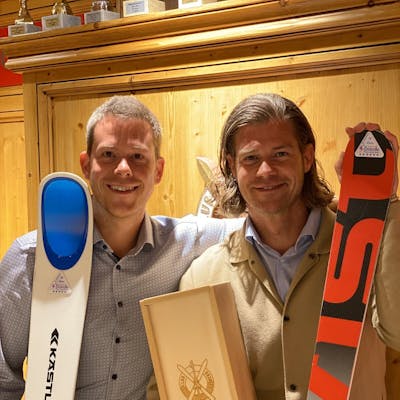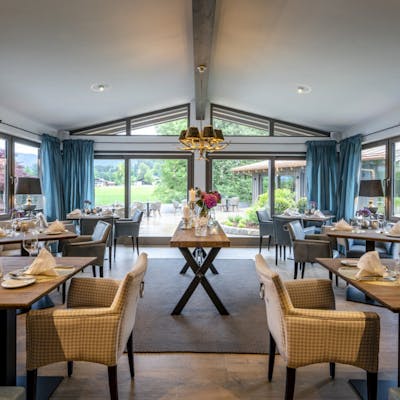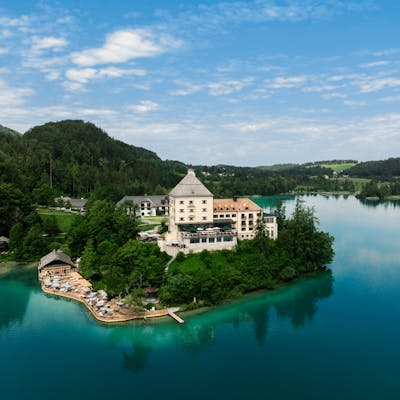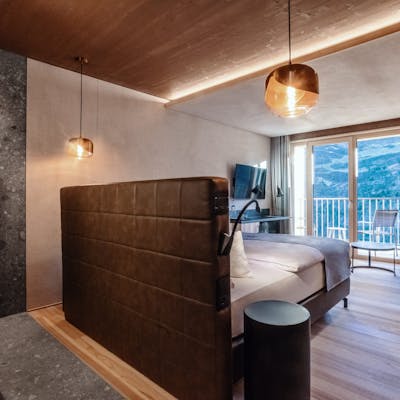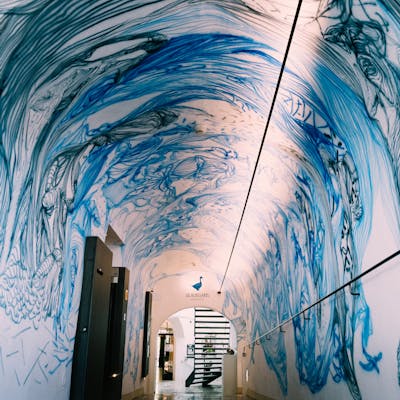

Nature’s magic
When images of stunning mountainous landscapes and snow-covered slopes leave you longing ...


No other genre opens up more space for dreams than outdoor photography. And only few people - like Lucas Tiefenthaler - get to experience nature in all its original beauty. The talented photographer has been close to nature ever since he was a child. From his early years it has shaped him and even today it is his biggest source of energy. With his camera he captures dramatic mountain vistas and wild, epic landscape scenarios all around the globe and just outside his door in and around Lech Zürs. It’s a fascinating mixture of natural experience, modern adventure, creativity, and technique that makes his work so special. In his interview he told us more.
L.L. / How did you become a photographer?
L.T. / I’ve always been fascinated by photography. Even as a child I would borrow my parents’ ancient film camera and take my own snapshots. I just had so much fun doing that. And I was always fascinated by what the photos looked like once they were developed. But soon I wanted more, which is why I switched to digital photography. I bought my first single-lens reflex camera, and I loved it, I loved all the possibilities that came with it. Because I grew up with mountains and feel very connected with them and because I practically grew up with skis under my feet, bringing the camera into the mountains was the obvious choice.

.
Soon my two biggest passions, exploring mountains and photography, became one. I purchased more and more camera equipment, read many books, watched innumerable videos on photography, and tried out as much as possible while out in the mountains. At the beginning I made many annoying mistakes, but I soon learned from them and kept trying to get better. I shared my progress on social media. When I was 18, I became a self-employed photographer while still going to school. After I graduated in 2019, I decided to focus on photography full-time and explore the world. I love showing my perspective of things to the world and overcoming my own boundaries.
“I find photographing skiers in the open landscape particularly fascinating.”
L.L. / In your opinion: what details make a good photo?
L.T. / I think that’s a very individual and subjective thing. In many cases the photos we remember best aren’t the “perfect” ones, but rather the ones that tell a story, that trigger emotion, that take us on a journey or generally trigger something in us. That may happen because of the unique composition of the shot, the perspective, an interplay of light and shadow, a unique motif, the right colours and contrasts, or depth of field. Sometimes it’s a combination of all of that. Sometimes it is less than that. There are photos that are perfect from a technical perspective but that may lack a certain something. It often is a matter of feeling for me and I think there is no right or wrong. There are so many different styles and directions. One person might find something boring while the other sees a masterpiece.
“One person might find something boring while the other sees a masterpiece.”
L.L. / Landscape photography means being in the right place at the right time. What role does coincidence play and how important is painstaking preparation for a shoot?
L.T. / At the beginning of my career as a photographer I never did much planning, I simply went out there and photographed everything I deemed interesting. Meanwhile planning and preparation have become a large part of my daily work. Especially when I spend the night on a summit in order to get the best photos, I start planning early and I often try and visualise the result before the shoot. I have a fixed idea in my head of what I want to show to the world. Using certain apps and tools I can find out the exact position of the sun, the moon, or the milky way and choose my spot accordingly. Yet: Planning is nice and all, but I still engage with the landscape when I’m there and I photograph what jumps out at me. Every once in a while, I deviate from my plan. And, of course, I have no influence on the conditions around me. I can be most fastidious about my planning and compare a number of different weather reports but sometimes the weather will simply put a spoke in my wheel.
“However, the most beautiful moments often aren’t the ones you plan ..."
From snow-storms, thick fog, thunderstorms to hail, I’ve seen it all. However, the most beautiful moments often aren’t the ones you plan but rather the ones that happen spontaneously and that will leave you speechless. The art is making the best of it, reacting quickly and with flexibility to whatever changes you encounter and to know when it is time to stop. And a lot of it simply is luck. If you are patient and able to bounce back after setback and if you keep trying you will definitely be rewarded sooner or later.
“The mountain landscape simply is magical.”
L.L. / And what is it exactly that makes the landscape around Lech Zürs so appealing for you?
L.T. / To a certain extent Lech Zürs has become a home for me. When I was a child, I spent a lot of time here with my family. It just is so charming when the small villages are dipped in white and the sun comes out, or when spring is upon Lech Zürs and there are beautiful flowering meadows everywhere. No matter where I go, the unique and impressive landscape of Lech Zürs always has a magical pull on me. I feel at home here. That’s why, over the past years, I focused on Lech and its surroundings. Nowadays I also feel a pull that draws me out into the world – but still: Lech Zürs will always remain a part of me and I will always come back to take new pictures here.
“Lech Zürs will always remain a part of me ..."
L.L. / Do you have a favourite motif in Lech Zürs?
L.T. / There is an incredible wealth of beautiful motifs in Lech Zürs – from Rote Wand to Omeshorn or the lake Monzabonsee or sunset on Großer Trittkopf and a thousand more. The mountainous landscape simply is magical. It’s impossible to decide on one of them. What I love in winter, for example, is getting up early and coming out of Flexengalerie towards Zürs, diving into the magical mountain world and seeing the first rays of the sun touch the tips of the mountains. Or in summer, when you hike up to Mohnenfluh at 2 am and watch the sun rise from the summit. Such moments make my heart beat faster. And one mountain I’ve always found fascinating is Roggspitze.
“Generally speaking, I like every season for my work ..."
L.L. / What is your favourite time of the year for taking pictures and why?
L.T. / Generally speaking, I like every season for my work because every season has its own qualities that I like to underline. I do, however, prefer winter. A winter landscape covered in fresh snow simply is special and stunningly beautiful. I think no other season can keep up with that. Winter just stands out because it so fundamentally changes the landscape. Also: I can combine landscape photography with freeriding and shoot even more interesting photos. And finding yourself on top of a mountain in winter – while often very, very cold – is all the more beautiful because the entire snow-covered landscape turns a mesmerising shade of orange. Standing there to capture the landscape’s stunning beauty only to ride down the mountain on skis simply is magical.
WORDRAP
My most beautiful photo of/from Lech Zürs is …
L.T. / Lech at night with Omeshorn in the background.
When I don’t take pictures …
L.T. / I take care of my plants. I have more than 20 by now. Or I try out new activities that take me out of my comfort zone, like parachuting, paragliding, exploring the world on my own and many more.
I think selfies are …
L.T. / a fun change. Taking selfies with an instant picture camera has its own special charm.
I would like to take pictures of …
L.T. / a whale or a giant manta ray or, one day, of the mountains in Himalaya or Patagonia.
I would never take a picture of …
L.T. / phew, I simply can’t decide.
"What a feeling!"
L.L. / Aside from landscape shots your portfolio also contains pictures of skiers in action. Which do you prefer: landscapes or people?
L.T. / Both. It all started with landscape photography for me, and I’ve remained true to that. At the same time my curiosity also makes me combine people with objects and create contrast there. I find photographing skiers in the open landscape particularly fascinating. Most of the time you only have a single try to get the best shot of a skier in a certain spot. There also are endless possible combinations when you look at your own work from an artistic viewpoint. That’s something I want to focus on more in the future. Last winter I had a photo project by the Erzberg in Zürs. I wanted to combine a skier’s curve with the curve of Flexenstrasse during the blue hours. All winter long I tried to put the project into practise but still: there was always something that wasn’t quite right. In the end there only was a single day during that whole winter when the conditions were ideal. I needed the perfect moment when everything would be 100 percent right – and in the end it came. What a feeling!
"It all started with landscape photography for me ..."
L.L. / What was the most impressive motif you ever got to photograph?
L.T. / That would have been during my trip around the world when I stopped in Hawaii. I was out and about with a marine biologist, and I got the chance to dive with sharks in their natural environment and photograph them under water. That was an unforgettable moment, and it still is one of the most beautiful and impressive of my entire career as a photographer. It showed me what fascinating creatures sharks are and how important it is to safeguard them.
“I want to invite the observer to come on a little trip into my own world.”
L.L. / Is there anything in particular viewers should look out for in your pictures? What are you trying to convey?
L.T. / I want to invite the observer to come on a little trip into my own world. I want to inspire their dreams and show them what stunningly beautiful moments life has to offer and just how breathtaking our nature can be. We simply must never lose our connection with her.
Begonnen hat alles mit einer uralten Filmkamera der Eltern. Ein Klick und schon entzündete sich sein brennendes Feuer für die Fotografie. Als Spezialist für Landschaftsfotografie und Actionaufnahmen und Freelancer seit 2018 kreiert Lucas Tiefenthaler heutzutage anspruchsvolle Bilder, die den Betrachter faszinieren und die besondere Stimmung der Szene einfangen.



 Add to Favourites
Add to Favourites




















